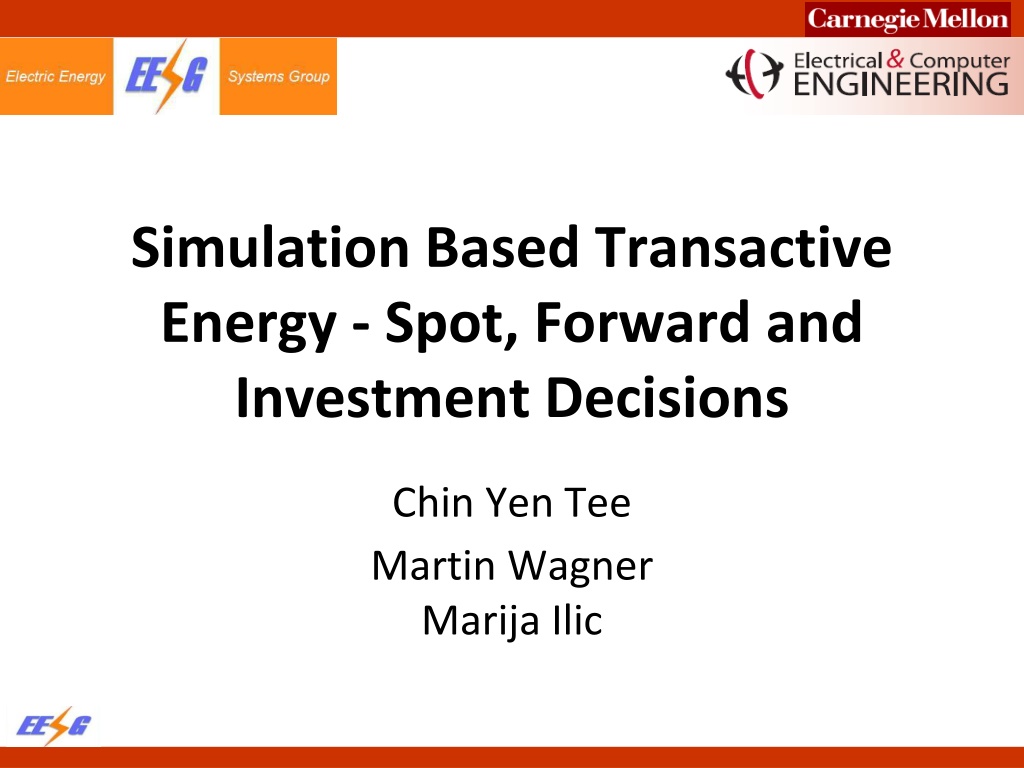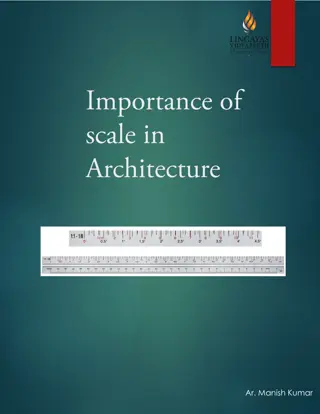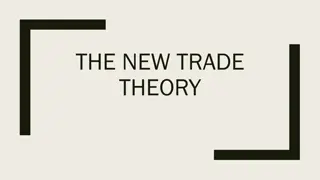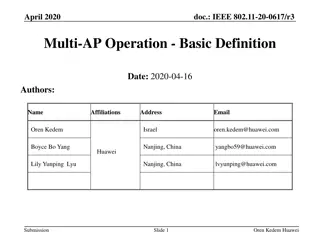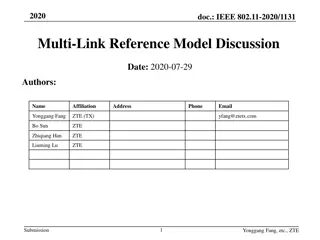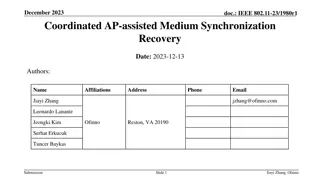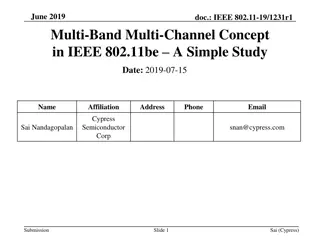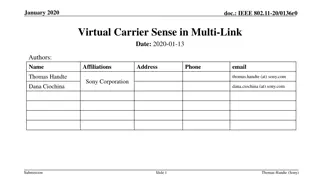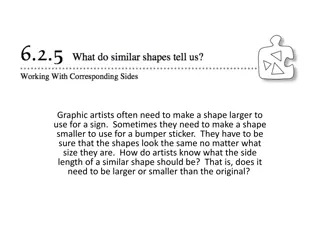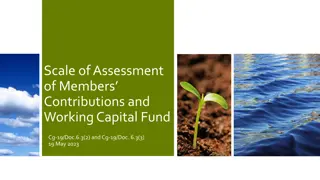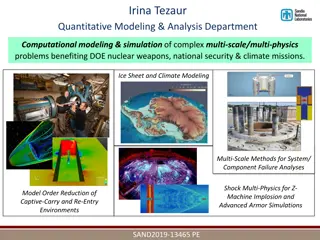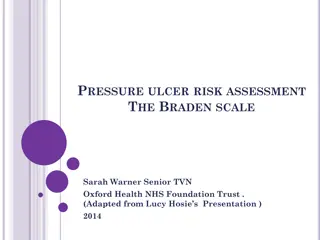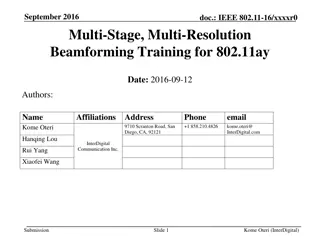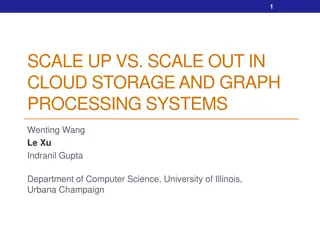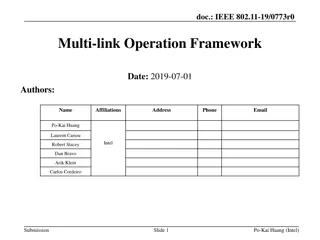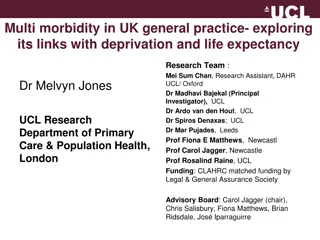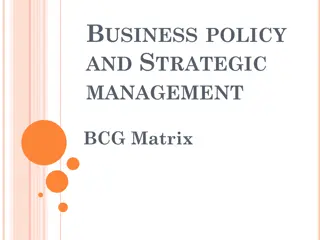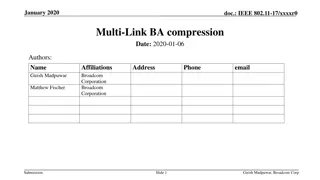Multi-Time-Scale Market Implementation on SGRS
Vision of SGRS facility for researchers and policymakers to test novel decision-making frameworks, SGRS simulator for power system simulations, and simulation-based transactive energy market design. The process involves waiting for signals, calculating bids, submitting investment bids, and clearing markets in different states. Use of NE ISO historical load data to build load model and test various market structures like spot, independent investment, coordinated investment, and forward markets on a modified Garver 6-bus test system.
Download Presentation

Please find below an Image/Link to download the presentation.
The content on the website is provided AS IS for your information and personal use only. It may not be sold, licensed, or shared on other websites without obtaining consent from the author.If you encounter any issues during the download, it is possible that the publisher has removed the file from their server.
You are allowed to download the files provided on this website for personal or commercial use, subject to the condition that they are used lawfully. All files are the property of their respective owners.
The content on the website is provided AS IS for your information and personal use only. It may not be sold, licensed, or shared on other websites without obtaining consent from the author.
E N D
Presentation Transcript
Simulation Based Transactive Energy - Spot, Forward and Investment Decisions Chin Yen Tee Martin Wagner Marija Ilic
Smart Grid in a Room Simulator Matlab algorithms State-machine driven Distributed simulation Actor orientation SGRS Event - Driven DyMonDS* Power system Simulations Scalability * Provisional Patent
Vision of SGRS Facility for researchers and policymakers to test novel, intelligent decision making frameworks, control designs, and institutional structures. Use case examples: Distributed automated modelling of power system dynamic [1] Retail market for reliability [2] Participation of electric vehicle in retail market [3] Focus of Today s Presentation: Simulation-based Transactive Energy Market Design 3
Multi Time-Scale Market Implementation on SGRS Gen +step(): State 0: Wait for Start Signal LSE +step(): State 0: Wait for Load Series/Forecast Send Signal To ISO Start Simulation State 1: Wait for Forward and RT Prices Calculate Forward and RT market bids Send Bids to ISO Iterate State 1: Wait for Forward and RT Prices Calculate Forward and RT market bids RT market bids for time t Forward market bids for time t + T Send Bids to ISO Iterate State 2: Wait for Estimated Future Price Calculate Investment Bids Submit Bids to ISO Iterate Transmission Owner ISO +step(): State 0: Wait for Investment Start Signal +step(): State 0: Wait for Start Signal from LSE Send Start Signal to Start Simulation State 2: Wait for Estimated Future Price Calculate Investment Bids Submit Bids to ISO Iterate State 1: Wait for Forward and RT Bids Clear Forward and RT Market Send Dispatch and Prices Iterate State 2: Send Estimated Future Prices Wait for Investment Bids Clear Investment Market (If Appropriate) Iterate Additional Load Simulator object to generate load series and forecast 4
Test on 6 Bus Test System Modified Garver 6 Bus Test System 1 5 Use NE ISO Historical Load Data to build load model Generation and transmission investment under different market structure Spot Only Spot + Independent Investment and Forward Market Spot + Coordinated Investment and Forward Market 4 3 2 6 5 * Darker color: More expensive generation **Blue line: Line 3 in results
Independent vs. Coordinated Forward and Investment Markets Independent Forward and Investment Markets 0 T T+t T +2t t 2t @ t: Spot Market for t, Forward Market for time T+t @T: Investment Market @ 2t: Spot Market for 2t Forward Market for time T+2t Coordinated Forward and Investment Markets 0 T T+t T +2t t 2t @T: Investment Market + Forward Market for all t between T and 2T @ t: Spot Market for t @ 2t: Spot Market for 2t Modular, state-machine driven simulation design makes it easy to implement different multi-timescale market design once basic framework has been established. 6
Differences in Investment Decisions Generation Investment Transmission Investment Case Spot Only None Investment in Line 3 Spot + Independent Forward Investment in Gen 1 and Gen 6 Investment in Line 3 Spot + Coordinated Forward None Investment in Line 3 7
Comparison of Spot and Forward Price for Coordinated (C) vs Independent(I) Forward Clearing for Typical Load Days Coordinated forward and investment clearing typically results in lower forward price as it accounts for effect of transmission/generation investment Lower forward price discourages investment 8
Generator 1 Revenue With and Without Forward Market for Case with Independent Forward Market (50 Real Time Load Realizations) Forward market in this case results in higher generator revenue on average market structure favors generator 9
Generator 1 Revenue With and Without Forward Market for Case with Coordinated Forward Market (50 Real Time Load Realizations) Forward market in this case results in lower generator revenue on average market structure favors load (Recall that generator did not invest in this case) 10
Conclusion Simulators such as the SGRS are well suited for simulation based market design for transactive energy markets Aid in understanding market effects (e.g. who wins/who loses) Aid in understanding interaction between markets at different time scales Help identify design questions for further evaluation Modular, state-machine based simulation framework design makes it easy to quickly test different market structures once the basic framework has been established 11
References [1]M. Wagner, K. Bachovchin, M. Ilic, "Computer Architecture and Multi Time-Scale Implementations for Smart Grid in a Room Simulator," 9th IFAC Symposium on Control of Power and. Energy Systems (CPES), New Delhi, India, December 2015. [2] Siripha Junlakarn (2015),Retail Market Mechanism in Support of Differentiated Reliable Electricity Services, PhD Dissertation, Carnegie Mellon University [3] Jonathan Donadee (2015), Operation and Valuation of Multi-Function Energy Storage Under Uncertainty, PhD Dissertation, Carnegie Mellon University 12
Extended Slide Deck ** Whitepaper to be released in June 2016. Email ctee@andrew.cmu.edu to request copy of whitepaper. 13
Vision of SGRS Facility for user/algorithm designers to test and scale their algorithms to real world problems. Use case examples: Distributed automated modelling of power system dynamic [1] Retail market for reliability [2] Participation of electric vehicle in retail market [3] Focus of Today s Presentation: Simulation-based Transactive Energy Market Design 15
Smart Grid in a Room Simulator Matlab algorithms State-machine driven Distributed simulation Actor orientation SGRS Event - Driven DyMonDS* Power system Simulations Scalability * Provisional Patent
Transactive Energy Market Design Many different forms/proposals TeMix work of Ed Cazalet Double auction market (E.g. GridWise Olympic Peninsula Demonstration) Fundamental ideas: Distributed decision making at value Multiple time-scale market SGRS designed to manage these fundamental ideas to test different transactive energy market designs. 17
Multi Time-Scale Market Implementation on SGRS Gen +step(): State 0: Wait for Start Signal LSE +step(): State 0: Wait for Load Series/Forecast Send Signal To ISO Start Simulation State 1: Wait for Forward and RT Prices Calculate Forward and RT market bids Send Bids to ISO Iterate State 1: Wait for Forward and RT Prices Calculate Forward and RT market bids RT market bids for time t Forward market bids for time t + T Send Bids to ISO Iterate State 2: Wait for Estimated Future Price Calculate Investment Bids Submit Bids to ISO Iterate Transmission Owner ISO +step(): State 0: Wait for Investment Start Signal +step(): State 0: Wait for Start Signal from LSE Send Start Signal to Start Simulation State 2: Wait for Estimated Future Price Calculate Investment Bids Submit Bids to ISO Iterate State 1: Wait for Forward and RT Bids Clear Forward and RT Market Send Dispatch and Prices Iterate State 2: Send Estimated Future Prices Wait for Investment Bids Clear Investment Market (If Appropriate) Iterate Additional Load Simulator object to generate load series and forecast 19
Time Evolution on SGRS T_start: 2008-01-01T00:00:00.0Z T_step: PT60M LoadSimulator: LoadForecast: LSE: LoadForecast LSE,Gen: Bid ISO: Dispatch&Prices LSE,Gen: Bid T1: 2008-01-01T01:00:00.0Z Operation Cycle (1 Hour) ISO: Dispatch&Prices T2: 2008-01-01T02:00:00.0Z Events Wall Clock Time Simulation Time ISO: EstimatedPrice Trans,Gen:Investment Bid T8760: 2009-01-01T00:00:00.0Z T8761: 2009-01-01T00:01:00.0Z Investment Cycle (1 Year) T8762: 2009-01-01T00:01:00.0Z Step function of Object called T17520: 2010-01-01T00:00:00.0Z 20 20
Test on 6 Bus Test System Modified Garver 6 Bus Test System 1 5 Use NE ISO Historical Load Data to build load model Generation and transmission investment under different market structure Spot Only Spot + Independent Forward Market Spot + Coordinated Investment and Forward Market 4 3 2 6 21 * Darker color: More expensive generation **Blue line: Line 3 in results
Independent vs. Coordinated Forward and Investment Markets Independent Forward and Investment Markets 0 T T+t T +2t t 2t @ t: Spot Market for t, Forward Market for time T+t @T: Investment Market @ 2t: Spot Market for 2t Forward Market for time T+2t Coordinated Forward and Investment Markets 0 T T+t T +2t t 2t @ t: Spot Market for t @ 2t: Spot Market for 2t @T: Investment Market + Forward Market for all t between T and 2T 22
Simulation Assumptions Simulated 4 years - 3 investment cycles. 1 representative day per month simulated per year Future prices/bids estimated based on a stochastic distribution of potential future load conditions No investment lead time Relatively simple bidding strategy used for testing Generation bidding is non-gaming. (i.e SRMC for spot market and LRMC for forward market) Load bids consist of fix and elastic portion. Load penalized if its forward load purchase is less than 80% of what it requires from the grid in real time. 23
Nodal Prices for Coordinated Investment + Forward Iterative Market Clearing For Different Iteration Converged in 3 Iteration. For convergence, need to impose rule that LSE bids have to be greater than the bids in the previous iteration. (Area for Further Study) 24
Differences in Investment Decisions Generation Investment Transmission Investment Case Spot Only None Investment in Line 3 Spot + Independent Forward Investment in Gen 1 and Gen 6 Investment in Line 3 Spot + Coordinated Forward None Investment in Line 3 25
Comparison of Spot and Forward Price for Coordinated (C) vs Independent(I) Forward Clearing for Typical Load Days Coordinated forward and investment clearing typically results in lower forward price as it accounts for effect of transmission/generation investment Lower forward price discourages investment 26
Comparison of Spot and Forward Price for Coordinated (C) vs Independent(I) Forward Clearing for High Load Days In this case, this reduction in investment due to typically lower forward price results in greater volatility in spot prices for the coordinated case during peak load days. 27
Generator 1 Revenue With and Without Forward Market for Case with Independent Forward Market (50 Real Time Load Realizations) Forward market in this case results in higher generator revenue on average market structure favors generator 28
Generator 1 Revenue With and Without Forward Market for Case with Coordinated Forward Market (50 Real Time Load Realizations) Forward market in this case results in lower generator revenue on average market structure favors load (Recall that generator did not invest in this case) 29
Conclusion Simulators such as the SGRS are well suited for simulation based market design for transactive energy markets Aid in understanding market effects (e.g. who wins/who loses) Aid in understanding interaction between markets at different time scales (e.g. interaction between forward market and investment decisions) Simulation aided market design helps identify design questions for further evaluation 30
References [1]M. Wagner, K. Bachovchin, M. Ilic, "Computer Architecture and Multi Time-Scale Implementations for Smart Grid in a Room Simulator," 9th IFAC Symposium on Control of Power and. Energy Systems (CPES), New Delhi, India, December 2015. [2] Siripha Junlakarn (2015),Retail Market Mechanism in Support of Differentiated Reliable Electricity Services, PhD Dissertation, Carnegie Mellon University [3] Jonathan Donadee (2015), Operation and Valuation of Multi-Function Energy Storage Under Uncertainty, PhD Dissertation, Carnegie Mellon University 31
